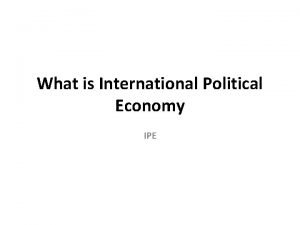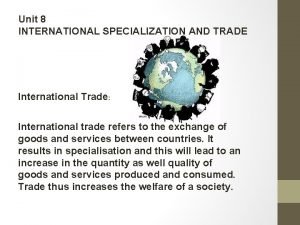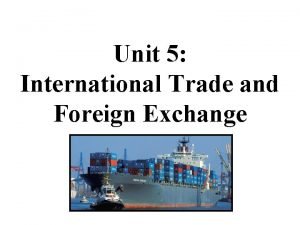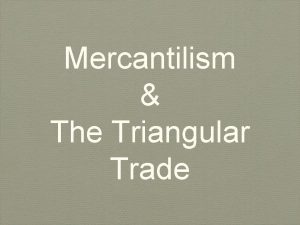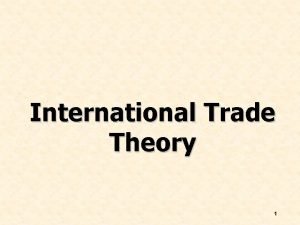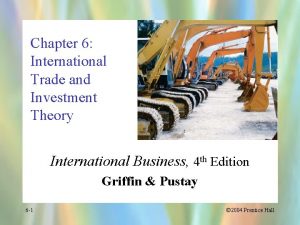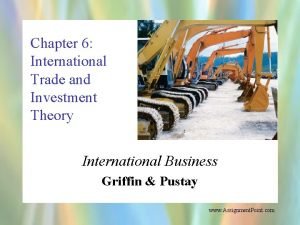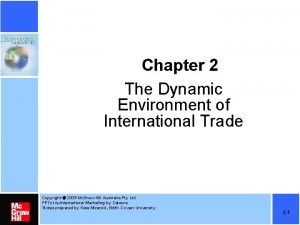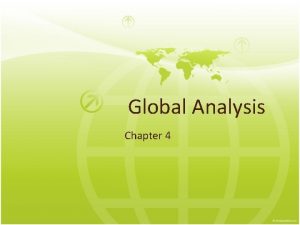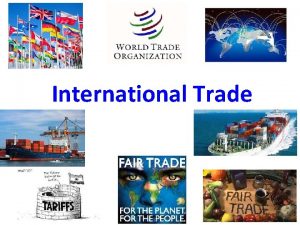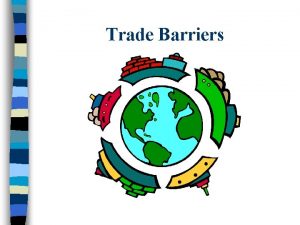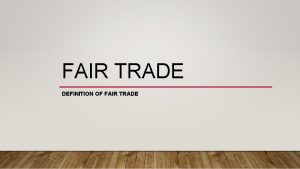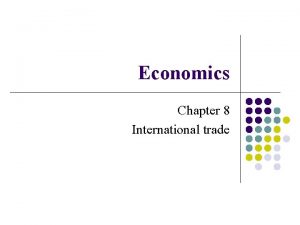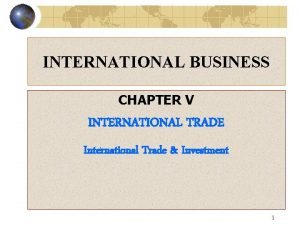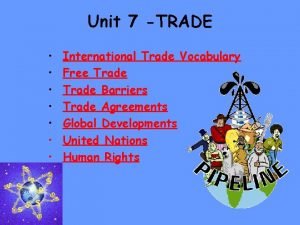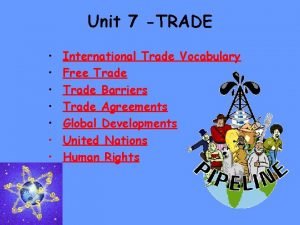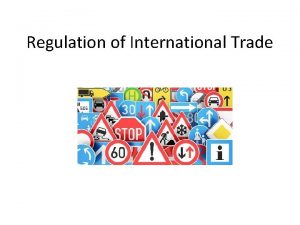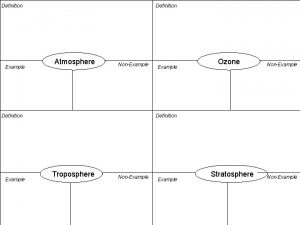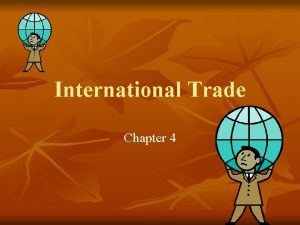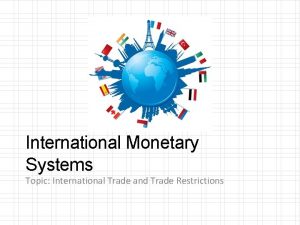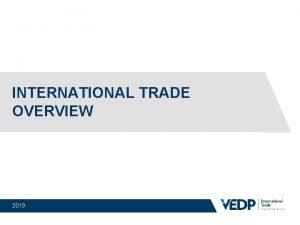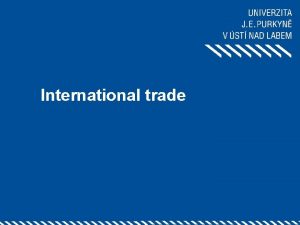INTERNATIONAL TRADE International Trade Definition n n International






















- Slides: 22

INTERNATIONAL TRADE

International Trade - Definition n n International trade involves the exchange of goods or services between nations. This is described in terms of – Exports: the goods and services sold in foreign markets. – Imports: the goods or services bought from foreign producers.

Try to identify some US exports. AIRCRAFT CROPS PHARMACEUTICALS Livestock

Try to identify some imports for the US Automobiles IRON

FOR SOME OF YOU THESE ARE YOUR MAJOR IMPORTS…… Canada United Kingdom & Ireland

Free Trade vs. Trade Barriers n Nations can trade freely with each other or there are trade barriers. – Free Trade: Nothing hinders or gets in the way from two nations trading with each other. – Trade Barriers: Trade is difficult because things get in the way. n There are costs and benefits related to free trade as well as trade barriers.

Free Trade - Benefits n n n When nations specialize and trade, total world output or sales is increased. Companies can produce foreign markets as well as domestic markets (markets in the home country). This means there is potential for making more money as there are more markets to sell goods or services in. More variety of goods are available from a world market than just a domestic market. Prices of goods are decreased through increased competition.

Free Trade - Costs n The domestic (home) country can lose money because the foreign goods allowed into the market increase competition and make it less likely people will buy domestic products. – Example: In the U. S. , people might want to buy a foreign automobile like a Honda or Toyota instead of an American made car. n n Increased competition means lower prices. Less money will go into the domestic market place and this can cause factories to be closed and jobs to be eliminated.

NAFTA: North America Free Trade Agreement

1. 2. 3. 4. 5. NAFTA Pros Cons Jobs and factories have been shipped to Mexico, but supplier is not shipped. In other words, US manufacturer Factories are relocated, and jobs are cut. continue to purchase from their supplier in US Mexico benefits from this trade, since more jobs are created for low income Mexican people, and help build the Mexican economy. NAFTA brought in a flood of foreign investment and contributed to a 24% rise in Mexico's per capita income. Its mission is to increase number of Mexican jobs, increase The opposite effect is that Americans are losing their jobs, increase US trade deficit. The pact has destroyed Mexico's small farmers, and bringing in an influx of subsidized U. S. food imports Data have shown NAFTA is ineffective in standard of living, and thereby decrease the illegal Mexican stemming the tide of illegal Mexican immigrants entering US US companies near the border are gaining positive results from NAFTA immigrants entering the US to find jobs. US companies away from the border are gaining negative results from NAFTA,

Trade Barriers – Three Types n n Barriers to trade are things that hinder or get in the way of trading. They can be cultural, physical , or economic. – Cultural barriers: language, currency, belief system. – Physical barriers: mountains, rivers, etc. • Example: The Alps Mountains in Europe – Economic barriers: government rules that restrict, block or discourage international trade between countries.

Trade Barriers - Economic n The most common trade restrictions are: – tariffs, which are taxes on imports. – quotas, which are limits on the quantity that can be imported. – embargos, which are a complete trade block usually for political purposes.

Tariffs n n n A tariff is a tax put on goods imported from abroad and sometimes referred to as custom duties. It is the most used and most familiar type of trade restriction. The effect of a tariff is to raise the price of the imported product. It makes imported goods more expensive so that people are more likely to purchase domestic products. The money received from the tariff is collected by the domestic government.

Quotas n n n A quota is a limit on the amount of goods that can be imported. Putting a quota on a good creates a shortage, which causes the price of the good to rise and makes the imported goods less attractive for buyers. This encourages people to buy domestic products. A quota on shoes, for example, might limit foreignmade shoes to 10, 000 pairs a year. If Americans buy 200, 000 pairs of shoes each year, this would leave most of the market to American producers.

Embargoes n n Embargoes are a government order which completely prohibits trade with another country. If necessary, the military actually sets up a blockade to prevent movement of merchant ships into and out of shipping ports.

Embargoes (con’t) n n The embargo is the harshest type of trade barrier and is usually enacted for political purposes to hurt a country economically and thus undermine the political leaders in charge. Such was the case with the Cuban embargo which has been in place since the 1960 s.

Trade Barriers - Benefits TOO BAD THIS DOESN’T EXIST FOR BIEBER n n Most barriers to trade are designed to prevent imports from entering a country. Trade barriers provide many benefits: – – protect homeland industries from competition protect jobs help provide extra income for the government. Increases the number of goods people can choose from. – Decreases the costs of these goods through increased comp

Trade Barriers - Costs n n n Tariffs increase the price of imported goods. Less competition from world markets means there is an increase in the price. The tax on imported goods is passed along to the consumer so the price of imported goods is higher.

Trading with China (Trade Deficit)

TRADING WITH CHINA China’s exports to US amounted to $325 billion or 17. 1% of overall Chinese exports. 5. Toys, games: $12. 3 billion 1. Machines, engines, pumps: $82. 1 billion 6. Clothing (not knit or crochet): $12. 3 billion 2. Electronic equipment: $68. 1 billion 7. Footwear: $12 billion 3. Furniture, lighting, signs: $17. 6 billion 8. Plastics: $9. 5 billion 9. Vehicles: $8. 5 billion 4. Knit or crochet clothing: $13. 2 billion 10. Iron or steel products: $8 billion

TRADING WITH CHINA America’s exports to China amounted to $103. 9 billion or 7% of overall US exports. 1. Machines, engines, pumps: $12. 2 billion 6. Medical, technical equipment: $5. 7 billion 2. Oil seed: $10. 7 billion 7. Plastics: $5. 1 billion 3. Electronic equipment: $10. 1 billion 8. Wood: $4 billion 4. Vehicles: $6. 8 billion 5. Aircraft, spacecraft: $6. 4 billion 9. Copper: $3. 8 billion 10. Organic chemicals: $3. 5 billion

TRADING WITH CHINA n US 2010 trade data: n In 2010, the US trade deficit grew to $497. 8 from $374. 9 billion in 2009. n America’s trade gap with China for 2010 swelled to $273. 1 billion, topping the 2008 record of $268. 0 billion. n 54%of America’s total trade deficit is generated by unbalanced trade with China.
 Definition of international trade
Definition of international trade Trade diversion and trade creation
Trade diversion and trade creation Trade diversion and trade creation
Trade diversion and trade creation Which is the most enduring free trade area in the world?
Which is the most enduring free trade area in the world? The trade in the trade-to-gdp ratio
The trade in the trade-to-gdp ratio Fair trade not free trade
Fair trade not free trade Trade diversion and trade creation
Trade diversion and trade creation Tramp trade software
Tramp trade software Ted talk slave trade
Ted talk slave trade Marxist ipe
Marxist ipe Specialization in international trade
Specialization in international trade Difference between balance of trade and balance of payment
Difference between balance of trade and balance of payment Mercantilism
Mercantilism Materi current theory of international trade
Materi current theory of international trade Classical theories of international trade
Classical theories of international trade International trade theory
International trade theory New trade theory
New trade theory Chapter 6 theories of international trade and investment
Chapter 6 theories of international trade and investment Modern firm based trade theories
Modern firm based trade theories Importance of international trade
Importance of international trade The dynamic environment of international trade summary
The dynamic environment of international trade summary Ifslearning
Ifslearning Benefits of international trade
Benefits of international trade









